News 2015
December 14-18, 2015: American Geophysical Union Fall Meeting. Luca Trevisan presented a talk with co-author Tip Meckel "Capacity Estimation of Capillary Trapping of CO2 in Heterogeneous Saline Aquifers Through 3-D Invasion-Percolation Simulations at the cm-to-m Scale." J.-P. Nicot and Roxana Darvari, along with other co-authors presented "Identifying the Sources of Methane in Shallow Groundwaters in Parker and Hood Counties, Texas through Noble Gas Signatures." Toti Larson, J.-P. Nicot, Pat Mickler, and Roxana Davari presented "Tracing natural gas transport into shallow groundwater using dissolved nitrogen and alkane chemistry in Parker County, Texas." Chanbing Yang and co-authors presented "A Multi-scale Approach for CO2 Accounting and Risk Analysis in CO2Enhanced Oil Recovery Sites." Changbing Yang, Patrick Mickler, Susan Hovorka, and Ramon Trevino were co-authors on "Field demonstration of CO2 leakage detection and potential impacts on groundwater quality at Brackenridge Field Laboratory." Chanbing Yang, Tip Meckel, Susan Hovorka, Ramon Trevino and others presented "Probability assessment of pressure and geochemical monitoring for CO2 leakage detection in the above zones at geological carbon sequestration sites." Alex Sun, Jiemin Lu, Susan Hovorka, Akand Islam, and another co-author presented, "Hydrogeology from 10,000 ft below: lessons learned in applying pulse testing for leakage detection in a carbon sequestration formation." Alex Sun was co-author on "Integrating GRACE and multi-source data sets to quantify the seasonal groundwater depletion in mega agricultural regions." Alex Sun, Akand Islam, and Jiemin Lu co-authored "Interpreting detailed brine chemistry changes during early periods of in-zone CO2 storage at Cranfield site, Mississippi, USA." Mahmoud Shakiba and Seyyed Hosseini presented "Application of Pressure Pulse Test Analysis in CO2 Leakage Detection and Monitoring." Seunghee Kim and Seyyed Hosseini presented "Constant Rate or Stepwise Injection of Cold Fluid into a Geologic Formation: A Hydro-Thermo-Mechanical Analysis." Reza Ganjdanesh and Seyyed Hosseini presented a poster "Impact of Brine Extraction and Well Placement Optimization on Geologic Carbon Storage Capacity Estimation." Seyyed Hosseini co-authored "Time Lapse Gravity and Seismic Monitoring of CO2 Injection at the West Hastings Field, Texas." Seyyed Hosseini, Changbing Yang, and J.-P. Nicot covened and/or chaired the sessions "Risk Assessment and Monitoring Techniques for Geological CO2 Sequestration I and II," and "Risk Assessment and Monitoring Techniques for Geological CO2 Sequestration III Posters." San Francisco, CA
December 14, 2015: Darin Damiani, Carbon Storage Program Manager for the DOE Office of Fossil Energy, invited Vanessa Nunez-Lopez to give a presentation of her project titled "Carbon Life Cycle Analysis of CO2-EOR for Net Carbon Negative Oil (NCNO) Classification" during the interagency CCS meeting. This is a meeting where the DOE, USGS, US EPA, DOJ, and BOEM meet from time to time in Washington to keep each other informed about events and issues related to CSS. The work was presented via Webex.
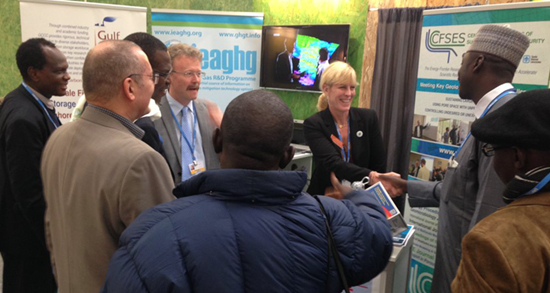
Katherine Romanak meets with climate delegates from around the world at the exhibit booth on carbon sequestration.
November 29-December 12, 2015: UNFCCC COP21 Paris Climate Talks. Katherine Romanak and Hilary Olson are attending the historic meeting as representatives of both GCCC and UT Austin and are leading outreach efforts on carbon sequestration by hosting several events. Katherine spoke at a Side Event at the COP on December 1, with co-organizers CO2GeoNet, International Energy Agency Greenhouse Gas Research and Development Programme, and Carbon Capture and Storage Association. Katherine and Hilary are also hosting an Exhibit Booth inside the COP for the entire two-week duration of the meeting. The co-organizers are CO2GeoNet, International Energy Agency Greenhouse Gas Research and Development Programme, and Carbon Capture and Storage Association. UT Austin is also participating in a public outreach booth at the Climate Generations Areas, which is open to the public for two-week duration of COP. Co-hosts of this booth areCO2GeoNet, Global CCS Institute, International Energy Agency Greenhouse Gas Research and Development Programme, and French Club CO2. Please check the Twitter feed #UTatCOP for up-to-the-minute news. A report from the Side Event can be found here. Paris, France
December 8, 2015: Southwest Louisiana Geophysical Society. Jacob Anderson presented a talk, "Light Hydrocarbon Geochemical Changes during Migration through Overburden," at the monthly luncheon. Please click here for an abstract of the talk. Austin, TX
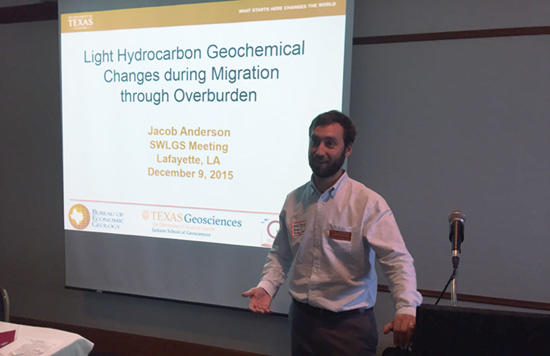
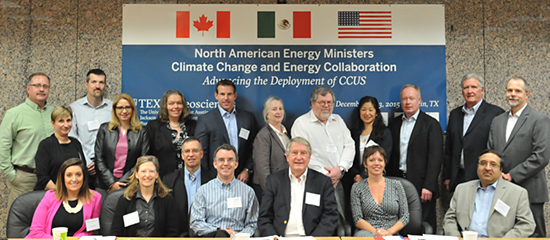
December 2-3, 2015: North American Energy Ministers Trilateral. GCCC hosted a field trip showcasing new carbon sequestration technology. The Trilateral focuses on building modern, resilient infrastructure for CCUS and promoting expertise and technical knowledge on CCUS among firms and research centers in Canada, Mexico, and the United States. Attendees include representatives from SENER, PEMEX, NRCan, and USDOE. For more coverage of the event, please click here. Austin, TX
December 1-3, 2015: Visit by Bob Wright of the Commission on Environmental Cooperation. GCCC is co-host along with the Climate Change Partnership. Austin, TX
November 17-19, 2015: Carbon Management Technology Conference 2015. Vanessa Lopez Nunez presented "Validating CO2-EOR as a CCUS Technology." Tip Meckel presented "Global Opportunities for Offshore CCS on Continental Shelves" and Accelerating CCUS Deployment for Non-Coal Energy Sources and Offshore Storage." Katherine Romanak gave a talk "Improving the Ease and Accuracy of Environmental Monitoring at CCS Sites." Seyyed Hosseini chaired a session on CO2 Utilization and Storage, Modeling and on Large Scale Storage. Sugarland, TX
November 18, 2015: Global CCS Institute held a "member's meeting" in association with the Carbon Management Technology Conference (CMTC 2015). Achievements of 2015 and plans for the coming years were discussed. The members included a small group of 15 people, including Julio Friedman of DOE, and representatives from Exxon, Shell, UKCSRC, CO2CRC, and others. Vanessa Nunez-Lopez was invited as an observer. Sugarland, TX
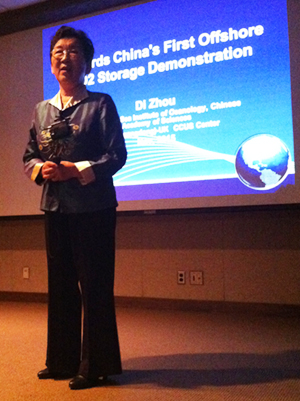
November 12-16, 2015: Invited Visit by Dr. Di Zhou. Since 2014, the US Department of Energy, Office of Fossil Energy has presented Awards to two distinguished Chinese scholars who champion the development of technologies related to pollution control and carbon management. These awards enhance global recognition of their achievements, their effectiveness within China, and their collaboration with the U.S. via information sharing and project development. Dr. Di Zhou is one of this year's Awardees, and has received an invitational speaking tour to the United States, where she will meet with current and future collaborators and also share her knowledge with a diverse set of audiences across the country. As part of the speaking tour, Dr. Zhou visited the GCCC and gave several presentations.
About the Prize:
In the past two decades, numerous energy-related research, development and demonstration initiatives have been successfully implemented between the U.S. and China via bilateral agreements and multilateral engagements, such as the fossil energy Protocol between DOE and China's Ministry of Science and Technology, the Carbon Sequestration Leadership Forum, the Clean Energy Research Center (CERC), and the CCUS initiative under the U.S. – China Climate Change Working Group. These efforts have promoted research and development, information sharing, and other technical cooperation. In the last few years, China has recognized the urgent need for pollution control and carbon management of existing power plants and coal conversion plants. It has intensified efforts to enforce regulations limiting emissions from these plants.
About the Invited Talk:
Guangdong, one of the five "Low Carbon Pilot Provinces" in China, has set a carbon reduction target higher than nation's average. A China-UK collaborative study confirmed the necessity of implementing CCUS in Guangdong in order to meet this target. The study developed a CCUS roadmap for Guangdong, which proposes a million-ton full-chain CCUS demonstration project as the key first step. The study also demonstrated that while inland Guangdong is not suitable for CO2 storage, the the Pearl River Mouth Basin (PRMB) offshore Guangdong in the northern South China Sea is a robust storage target.
In parallel to a study of CO2 capture from a power plant, a study of offshore CO2 storage has focused on seeking a suitable storage site in the PRMB. Prime targets are near depleted oil fields, as such fields provide savings both in cost and in time. By scoring and ranking producing oil fields in the PRMB, three candidate sites have been short-listed. Knowledge gaps in final site selection have been identified, including those in CO2-EOR potential, containment quality, and facility reuse.
These and future studies are now summarized under the title of the Guangdong CCUS Project, which has been carried out with international collaborations and received financial support from UK SPF and the GCCSI. In late 2013 the UK-China (Guangdong) CCUS Center was established. Recently the Guangdong CCUS Project has been listed in the U.S.-China Working Group on Climate Change.
About the Speaker:
Dr. Di Zhou was granted bachelor in 1965 from the South China Industrial University and a Ph.D. in 1984 from Kansas University. Since 1985, she has worked in marine geology and mathematical geology in the South China Sea Institute of Oceanology. She served as the Vice Director of the Institute and Chairman of the Scientific Steering Committee of the Institute, Council Member of the International Association for Mathematical Geologists, and Secretary of the International Committee of Quantitative Stratigraphy. She served as a Member of the Standing Committee and a Vice Chairman of the Committee for Population, Resources, and Environment in the Guangdong Provincial Political Consultant Committee. In 2003-2005 Dr. Zhou worked as one of the lead authors of Chapter 5 of the IPCC Special Report "Carbon Dioxide Capture and Storage." In 2006 she organized the first Clean Development Mechanism and CCS workshop in Guangdong Province. From 2009 to 2013, she led the first two research projects on CCS feasibility in Guangdong Province and since 2014 she has served as the Vice Chairwoman of the Consultant Committee of the UK-China (Guangdong) CCUS Center.
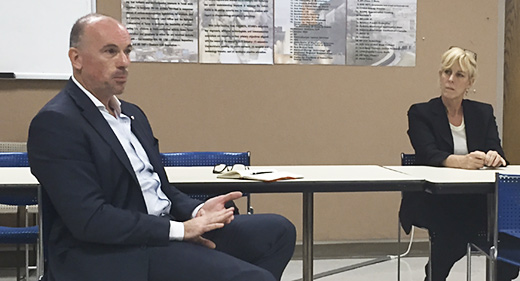
Dave Malloy from the University of Regina speaks to the GCCC, including Katherine Romanak (right)
November 6, 2015: GCCC was pleased to host a visit by Dave Malloy, Vice President of Research at the University of Regina in Saskatchewan, Canada. Dave is engaged in the University Network being set up by SaskPower to share the learnings from their Boundary Dam CCS project. This consortium will include research in storage and all aspects of CCS. GCCC discussed avenues of collaboration and looks forward to more productive interaction as the project gets underway.
October 26, 2015: Congratulations to Ana González-Nicolás and Luca Trevisan who have just published new papers on carbon sequestration.
Ana is the lead author on the paper, "Detection of potential leakage pathways from geological carbon storage by fluid pressure data assimilation", published in the journal Advances in Water Resources. The work proposes an inverse modeling method based on fluid pressure measurements collected in strata above the target CO2 storage formation, which aims at identifying the presence, the location, and the extent of possible leakage pathways through the caprock.
Luca is lead author on a new paper published in Water Resources Research titled, "Experimental analysis of spatial correlation effects on capillary trapping of supercritical CO2 at the intermediate laboratory scale in heterogeneous porous media." The work presents the results of an experimental investigation conducted in a synthetic sand reservoir developed to study geological heterogeneity at the intermediate (cm-to-m) scale. Capillary trapping performance was evaluated for three scenarios and x-ray attenuation was used to precisely measure phase saturation throughout the flow domain.
November 2, 2015: 6th CSLF Ministerial Meeting. Tip Meckel participated in the Stakeholders Session, which focused on offshore storage resources. Riyadh, Saudi Arabia
October 6-10: Masaryk University. Susan Hovorka participated in a CCS educational series giving two talks on US and RCSP progress and participating in a student workshop. The workshop was funded by Norway. Brno, Czech Republic.
October 8, 2015: Forty-three CCS scientists submitted an open letter to Ms. Christiana Figueres, Executive Secretary of the United Nations Framework Convention on Climate Change with assurances that CCS is secure and safe and critical to climate change mitigation. Susan Hovorka, Tip Meckel, and Katherine Romanak were among the signatories.
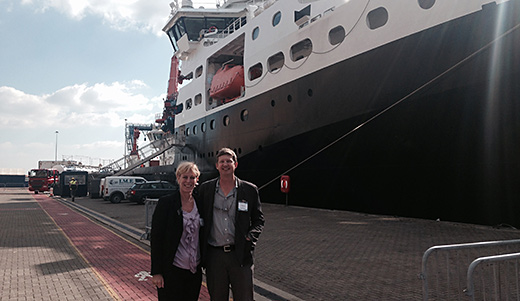
Romanak and Meckel in front of the RV Discovery at the National Oceanography Centre in Southampton.
September 29-October 2, 2015: IEAGHG Risk Management and Environmental Research Network Meeting. Tip Meckel presented information on recent seismic imaging of prospective CCS sites on the inner coastal shelf of Texas. Katherine Romanak provided insight on monitoring of CCS sites in onshore environments. The two led a discussion on initiatives for an international offshore CCS demonstration project. Discussion was also had on risk assessment methodologies, mitigation strategies, potential impacts of CO2 transport, the potential impacts of brine and CO2 release into the marine environment, overburden features, and utilization of autonomous underwater vehicles for monitoring offshore CCS sites. Southampton, UK
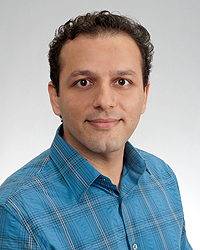
September 21, 2015: Congratulations to Seyyed Hosseini and colleagues at GCCC and GE Global Research who have received an award for a new project from DOE-NETL called "Pressure Management and Plume Control Strategies through a Brine Extraction Storage Test at the Devine Test Site." The project will test active brine extraction wells, passive pressure relief wells, and combinations of both, to control the pressure buildup in the storage formation. Under each pressure management strategy, a complete life-cycle analysis for brine, along with brine handling strategies, will be developed. The proposed study will include some lab and pre-pilot scaling work to obtain the design parameters for Phase II. The proposed field site is the University of Texas at Austin's Devine test site.
September 15-17, 2015: PCOR Partnership Annual Meeting and Workshop Seyyed Hosseini attended the meeting, which addressed CO2 management in the upper Great Plains of North America. Recent accomplishments and technologies, as well as regulatory developments, were discussed. Chicago, IL
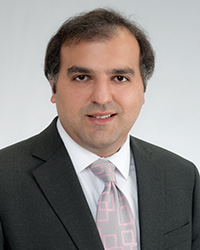
September 8, 2015: Congratulations to Houman Bedayat, who has been selected as a member of Future Leader Program of American Rock Mechanics Association (ARMA). The ARMA Future Leader Program identifies motivated ARMA members of outstanding promise relatively early in their careers to identify ideas for the continual development of ARMA. Future leaders are nominated by ARMA members and approved by current Leaders and the Board of Directors
September 6, 2015: ISO Technical Committee 265 Carbon dioxide capture, transportation, and geological storage. Susan Hovorka attended the meeting. Oslo, Norway
August 18-20, 2015: DOE/NETL Carbon Storage R&D Project Review Meeting. Susan Hovorka, Seyyed Hossieni, and Changbing Yang participated in a panel discussion on large-scale sequestration projects highlighting learnings from Cranfield. Katherine Romanak was on a panel discussing the IEAGHG Monitoring Network. Alex Sun presented "Pressure-based Inversion and Assimilation System (PIDAS) for CO2 Leakage Detection." Vanessa Nunez-Lopez presented "Life cycle analysis of CO2-EOR for Net Carbon Negative Oil (NCNO) Classification." Seyyed Hosseini presented "Enhanced Analytical Simulation Tool for CO2 Storage Capacity and Uncertainty Quantification." Pittsburgh, PA

August 17, 2014: Congratulations to Alex Sun, whose project "Development of a Framework for Data Integration, Assimilation, and Learning for Geological Carbon Sequestration (DIAL-GCS)" has been selected by the Department of Energy to receive funding through its Carbon Storage Program. The program advances the development of validation technologies that enable safe, cost-effective permanent geological carbon storage. DIAL-GCS will develop an intelligence monitoring system for automating GCS by allowing for the assimilation and analysis of heterogeneous data in a timely manner. The system's capabilities will be assessed using data from the SECARB Stacked Storage project at Cranfield, MS.

Scott Tinker (seated, second from right) with representatives of the U.S.-China Climate Change Working Group. Image Credit: U.S. Trade and Development Agency
June 22, 2015: U.S. and China to Collaborate on CCS
Officials from China and the United States met in Washington D.C. as part of the U.S.-China Strategic and Economic Dialogue (S&ED), which builds on the historic announcement last November in which the two countries pledged to work together to decrease carbon dioxide emissions. During the S&ED's climate change panel, Secretary of State John Kerry described enormous opportunities for the collaboration, and made special mention of carbon capture and storage.
Energy Secretary Ernest Moniz told reporters that the U.S. and China would cooperate with "unparalleled scientific activity" to develop CCS in saline aquifers. The Gulf Coast Carbon Center's significant expertise, both in the field and in the lab, has been tapped for this effort. At the meeting, BEG Director Scott Tinker, representing the GCCC, signed a Memorandum of Understanding of collaboration and knowledge sharing with the UK-China (Guangdong) CCUS Centre, Southern Company, and Clean Air Task Force.
Guangdong's integrated carbon capture and offshore storage project proposes to capture post-combustion CO2 from China Resources Power's Haifeng coal fired power plant for offshore geologic storage and enhanced oil recovery in China National Offshore Oil Company's oil and gas fields in the Pearl River Mouth Basin. Geological carbon storage in the Texas offshore, championed by GCCC researchers, is proposed as a counter-facing project for China's offshore project.
June 16, 2015: GCCC was delighted to welcome members of UT's Petroleum and Geosystems Engineering group including Matt Balhoff, Chung Huh, Paul Bommer, Jostine Ho, and Shayen Tvaossoli to our weekly meeting. Matt Balhoff presented new work on pH triggered gelant for sealing microannuli in wellbore cement. Potential collaborations were discussed. Austin, TX
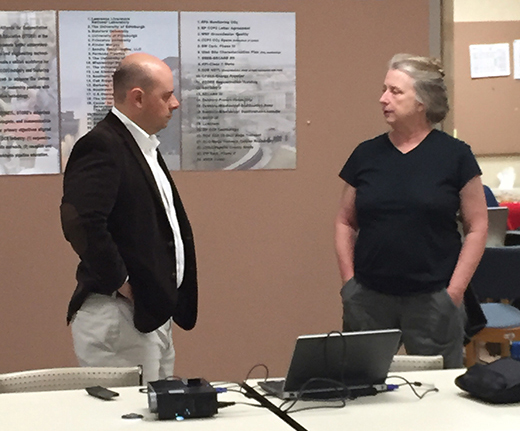
June 15-19, 2015: 2015 CSLF Mid-Year Meeting and Technology Workshop - Katherine Romanak attended the workshop hosted by SaskPower. The workshop included field trips to SaskPower's Boundary Dam CCS facility that is currently storing 1 million tonnes of anthropogenically-produced CO2 annually as well as their carbon capture test facility at Shand Station. Regina, Saskatchewan, Canada
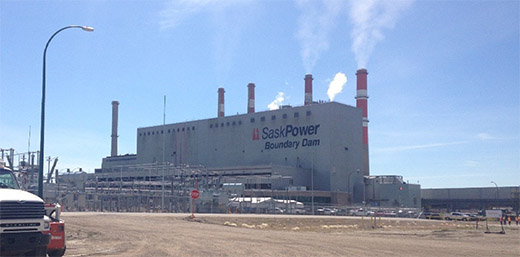
The absence of smoke at the second smokestack from the left at SaskPower's Boundary Dam project is evidence of CCS.
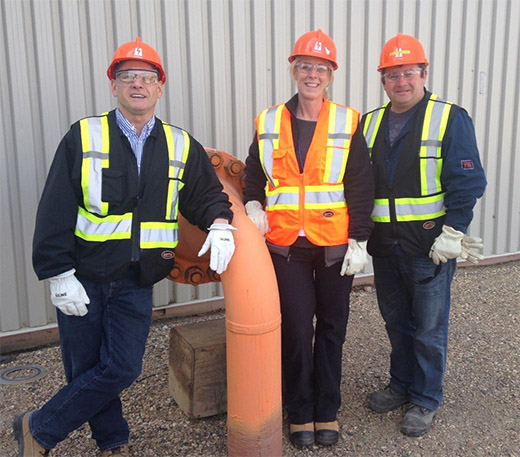
Katherine Romanak (center) standing next to the pipe carrying CO2 away from the capture facility at the Boundary Dam power plant
June 10-12, 2015: GCCC staff attended the IEAGHG 10th Monitoring Network Meeting hosted by the Lawrence Berkeley National Laboratory. Susan Hovorka and Katherine Romanak were on the steering committee for the meeting. Changbing Yang with co-authors Jesús Delgado, Sreekar Marpu, Narciso Guzman, and Straun Phillips presented the poster "Fiber Optic Distributed Sensors for Carbon Dioxide Detection." Katherine Romanak chaired a session on Monitoring Tool Development and presented "Scene Setting – the Detection-Attribution-Quantification Cycle." Susan Hovorka chaired a session on Monitoring Demonstration Projects and gave a talk on Post Closure Monitoring at Cranfield. She also gave a talk "Developing Monitoring Programmes for Large-Scale Projects: the Experience from CO2EOR." Susan also presented Seyyed Hosseini's talk, "Pressure Monitoring, Field Observations and Interpretation Challenges." Berkeley, CA
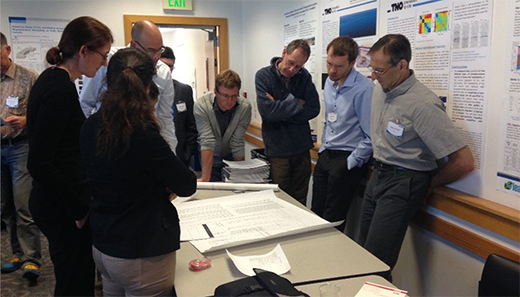
IEAGHG workshop attendees work on monitoring design activity developed by Sue Hovorka
June 8, 2015: GCCC researchers Changbing Yang, Susan Hovorka, Ramón Treviño, and Jesus Delgado-Alonso have just published a new paper in the journal Environmental Science and Technology titled "An Integrated Framework for Assessing Impacts of CO2 Leakage on Groundwater Quality and Monitoring-Network Efficiency: Case Study at a CO2-EOR Site." This study presents a method for combining site characterization, laboratory experiments, single-well push-pull tests, and reactive transport modeling to assess potential impacts of CO2 leakage on groundwater quality and leakage detection ability of a groundwater monitoring network in a potable aquifer at a CO2 enhanced oil recovery site.
June 6, 2015: GCCC was delighted to host visitors from Masaryk University including Pavla Filipská, Martin Jirušek, and Jan Osicka, Ph.D.who are working on means for developing CCS outreach mechanisms and technical transfer. Austin, TX

June 4, 2015: GCCC researcher Akand Islam has released an Android app called CO2Thermo that quickly provides CO2 thermophysical properties. This app calculates essential thermodynamic properties of CO2 including solubility of CO2 in water (g/L), compressibility factor, density (kg/m3), enthalpy (KJ/Kg), internal energy (KJ/Kg), entropy (KJ/Kg/K), Helmholtz energy (KJ/Kg), and Gibbs Free Energy (KJ/Kg) for given temperature (C) and pressure (bar). Audiences for this app are academic educators and students in the fields of chemical, mechanical, and petroleum engineering; physics; chemistry; and geoscience, as well as researchers and professionals working in the fields of CO2 sequestration, CO2 based geothermal energy, up- and mid-stream oil and gas operations, and other applications where CO2 is used as a working fluid.Please click to download the app.
June 3, 2015: Big congratulations to JP Nicot for his acceptance as a Fellow of the Geological Society of America. A GSA Fellowship is an honor bestowed on the best of in the geosciences profession once per year at the spring GSA Council meeting and is recognized at our yearly Annual Meeting. GSA members are elected to Fellowship in recognition of distinguished contributions to the geosciences.
June 2, 2015: Congratulations to a number of GCCC staff who received recent promotions. JP Nicot was promoted to Senior Research Scientist. Changbing Yang and Katherine Romanak were promoted to Research Scientists, as was GCCC collaborator Tongwei Zhang. We salute you for your excellent contributions not just to the Gulf Coast Carbon Center, but to The University of Texas at Austin, and the CCS community.
May 22, 2015: Congratulations to our Graduates!
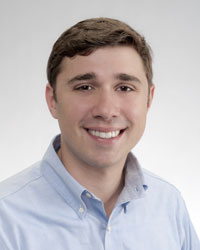
Michael Patson received a Masters degree for his thesis titled "The behavior of dissolved organic carbon (DOC) at geological sequestration sites." This research project was funded by the GCCC and the results help understand how DOC in shallow groundwater may be affected in the event of small or large-scale CO2 leakage from CO2 sequestration sites. Michael is currently working as a geologist at Cimarex Energy in Tulsa, Oklahoma.
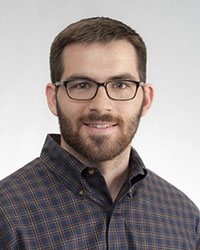
Francis Mulcahy completed requirements for a Masters degree with his thesis, "Use of High Resolution 3D Seismic Data to Evaluate Quaternary Valley Evolution History during Transgression, Offshore San Luis Pass, Gulf of Mexico," working with data collected by the GCCC's state-of-the-art P-cable as part of the Offshore Miocene project. Francis is now employed at Statoil, Houston working on petroleum exploration in the Gulf of Mexico.
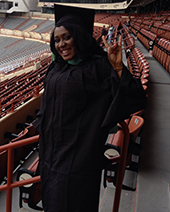
Prisca Ogbuabuo received her Masters degree for her thesis, "The Role of Methane in Limiting CO2 EOR: Case Study of Offshore Gulf of Mexico Reservoirs." Prisca helped to develop a best management practices manual for sub-seabed geologic carbon dioxide (CO2) sequestration on the U.S. outer continental shelf through analysis of (1) the applicability of existing regulations to offshore sub-seabed geologic sequestration, (2) injection of CO2 on the OCS for enhanced oil recovery (EOR) with incidental CO2 storage, and (3) long-term storage of CO2 without the added financial benefit of EOR.
May 20, 2015: Congratulations to Akand Islam, Tad Patzek, and Alex Sun, who have just published "Thermodynamics phase changes of nano pore fluids" in the Journal of Natural Gas Science and Engineering. The goal of the work is to compute pressures exerted by the fluid molecules and to investigate how they change due to pore proximity by assuming the pore wall is inert. The results clearly show the phase changes due to confinement. The critical shifts of temperatures and pressures are in good agreement compared to the laboratory data and molecular simulation. This work provides insights into the nature of fluid behavior in extremely low-permeability nanoporous media, especially in the tight shale reservoirs, below the critical temperatures.
May 15, 2015: We are delighted to announce the release of EASiTool 2.0 to the public and research community. This analytical simulation tool provides reliable estimation of storage capacity for any formation. It has been developed for technical and non-technical users with minimum engineering knowledge. For more information about EASiTool and for free download, please click here.
May 4, 2015: Tip Meckel and Ramon Trevino presented the poster "Offshore Texas Miocene CO2 Storage Project" at the Austin Geological Society Annual Poster Session at the University of Texas at Austin, Bureau of Economic Geology. Austin, TX
April 28 - May 1, 2015: GCCC staff took part in the Fourteenth Annual Carbon Capture Utilization & Storage Conference. Tip Meckel presented, "Regional Characterization of the Miocene Interval Offshore Texas, Gulf of Mexico for CO2 Storage" and "Accelerating Sustainability of Diverse Future Clean Energy Developments though CCUS." Katherine Romanak presented, "Technical Advances and Cost-Effective Monitoring: Results from a Case Study of Sensor Development for a New Process-Based Monitoring Method." Changbing Yang presented, "Numerical Assessment of Monitoring Network Efficiency for CO2 Leakage Detection: A Case Study at a CO2-EOR Site." Susan Hovorka presented "Merging Experience from Regulation of Injection with New Needs for Storage Certification" and "Subsea Geologic Storage in Continental Shelves – Global Research Needs, Potential, and Technical Issues." Pittsburgh, PA
April 28, 2015: BEG Industry Day. GCCC researchers and graduate research assistants participated in the annual even, which was held at BEG's Houston Research Center. As in previous years, GCCC and other BEG groups presented their research during a well-attended poster session. Becky Smyth presented "Monitoring CO2: the quest for a clean signal." Jacob Anderson presented "Light Hydrocarbon Geochemical Changes during Migration through Overburden: Proxy for Potential Geological Carbon Storage Leakage." Francis Mulcahy presented "Use of high resolution 3D seismic data to evaluate Quaternary valley evolution during transgression, offshore San Luis Pass, Gulf of Mexico." Dallas Dunlap and Ramon Trevino presented "High resolution 3D Imaging of Quaternary Channelization Offshore San Luis Pass, Texas." Johnathon Osmond presented "Fault observations in Lower Miocene to recent sediments using high-resolution shallow P-Cable and conventional offshore 3-D seismic data in the San Luis Pass, Texas." Other GCCC researchers in attendance were Sue Hovorka, Jiemin Lu, and Hilary Olson. GCCC staff members were happy to participate in discussions with a number of our industry sponsors who attended the meeting. Houston, TX
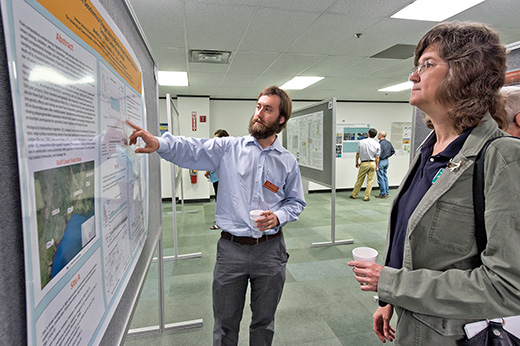
Jacob Anderson speaks with industry representatives about his research.
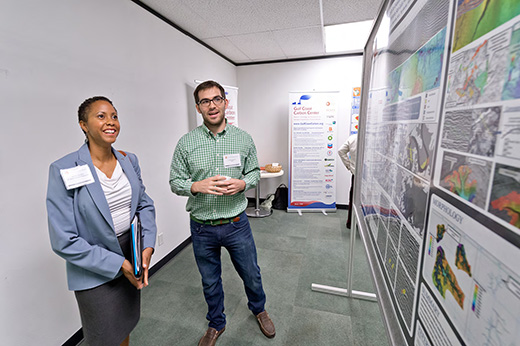
Francis Mulcahy speaks with industry representatives about his research.

Jonathan Osmond speaks with industry representatives about his research.
April 23, 2015: At its annual First Author Publication Awards Dinner, the Bureau of Economic Geology paid tribute to researchers who were first authors of papers published in 2014. Thirty-six first authors were recognized at this year's event, eight for the first time. GCCC post-doc Akand Islam had the most first-author publications in 2014, with a remarkable five articles. Congratulations Akand!
April 18-23, 2015: In support of the CCUS initiative of the U.S.-China Climate Change Working Group, Tip Meckel, Susan Hovorka and Jiemin Lu attended a series meetings and workshops in Beijing, Shanwei, and Guangzhou in China. One of the primary purposes of the visit was to attend the 2nd CCUS workshop of U.S.-China CCWG in support offshore CCUS in Gulf of Mexica and Guangdong offshore as potential counterfacing U.S.-China CCUS projects under CCWG initiatives. The other major objective is for Gulf Coast Carbon Center to establish working relationship with various Chinese research groups and industrial partners who are involved in potential offshore CCUS project in Pearl River Basin offshore Guangdong Province. The focus of GCCC efforts was to facilitate technical transfer with U.K.-China (Guangdong) CCUS Center to support the development of offshore CCS demonstration projects in both countries. Susan Hovorka called the trip both productive and prestigious.
During the workshop, Tip Meckel gave a talk, "U.S. Offshore CO2 Storage," which was followed by discussion with experts from China about ways to further collaborate and to develop strategies to promote Guangdong Offshore CCUS. Susan Hovorka gave a talk entitled "Critical role of reservoir characterization in CO2 EOR flood design" and discussed the potentials of modifying CO2 flood design according to reservoir properties to improve production performance at the Research Institute of Petroleum Exploration and Development (RIPED), PetroChina, in Beijing. The group also toured the Haifeng Power Plant of China Resources Power in Shanwei, Guangdong. Sue Hovorka, Tip Meckel and Jiemin Lu also presented GCCC's research on the past DOE-funded CCS projects at the South China Sea Institute of Oceanology, Chinese Academy of Sciences, Guangzhou, Guangdong. The trip was facilitated and hosted by the US Department of Energy.
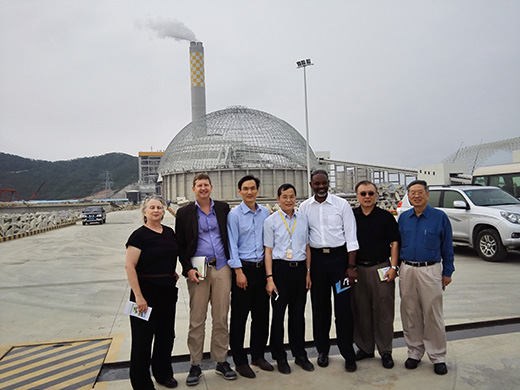
GCCC researchers (L to R) Susan Hovorka, Tip Meckel, Jiemin Lu, and Heping Zhu, Deputy Director of Technology, China Resources Power; a member of the U.S. counsulate; Samuel Tam, China Chief Representative, U.S. Department of Energy, and Dr. Ming Sung, Chief Representative, Asia Pacific, Clear Air Task Force at the Haifeng Power Plant of China Resources Power.
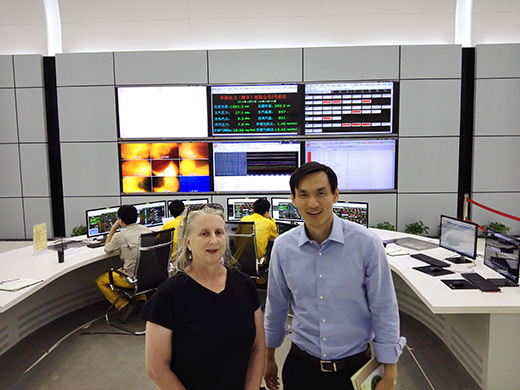
Susan Hovorka and Jiemin Lu visit the control room at the Haifeng Power Plant of China Resources Power.
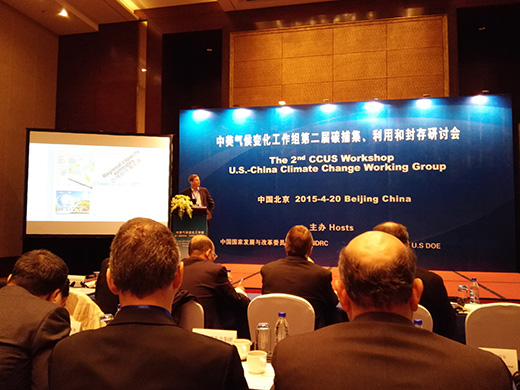
Tip Meckel presents GCCC's work on offshore CCS at the 2nd CCUS workshop of the U.S.-China Climate Change Working Group.
April 14, 2015: Congratulations to Akand Islam and Alexander Y. Sun who have just published the paper, Quantification of CO2 masses trapped through free convection process in isothermal brine saturated reservoir in the International Journal of Heat and Mass Transfer. The paper investigates dissolution trapping of supercritical CO2 into formation brine as a potential mechanism for reducing buoyancy force in carbon storage formations. This study attempts to quantify how much CO2 can be stored through dissolution trapping assuming the free-phase CO2 will be dissolved continuously on the top of perturbed brine phase. Most former investigations focused on physical explanations of density-driven free convection instability. The aim of this paper is to compute the amount of CO2 (by mass) captured by dissolution trapping until the model reservoir reaches steady state. On average, the simulations performed show that 0.33 – 15 g CO2 will dissolve per year until a heterogeneous unit reservoir volume of 1 m3 reaches complete saturations. For the case of homogeneous reservoir this amount is 0.28 – 6 g.
March 19-20, 2015: South Central Geological Society of America Annual Meeting. Jacob Anderson presented the talk "Light Hydrocarbon Geochemical Changes during Migration through Overburden: Proxy for Potential Geological Carbon Storage Leakage" and Mike Patson presented "Tracing the Effects of Fugitive CO2 on Dissolved Organic Carbon at Carbon Sequestration Sites." Stillwater, OK
March 11, 2015: SECARB 10th Annual Stakeholder's Briefing. Changbing Yang presented "Outcomes and Lessons Learned from Groundwater Monitoring." Lucie Costard presented "Near Surface Stratigraphy and Geophysics."
Susan Hovorka presented "Update on Reservoir Modeling, Final Testing, and P&A Underway" in which she discussed progress at Cranfield field. There, more than 5 million metric tons of CO2 have been injected for EOR, and monitored as part of the DOE-funded SECARB study. Groundwater was monitored at 13 wells over the site, and no evidence of leakage has been detected. Because no leakage has occurred, a series of experiments were conducted to determine how leakage would be detected, should it occur. They included lab reaction of groundwater with aquifer rocks and CO2; field test where CO2-saturated water was injected to see how it interacts with the rock-water system, and reactive transport modeling. The major findings are:
- At this site, like others studied, CO2 added to the aquifer does not release any hazardous constituents.
- The best analysis for detecting if CO2 has entered the aquifer is dissolved CO2 and dissolved inorganic carbon (DIC).
- In a natural system with natural variability, the change from CO2 entering the aquifer cannot be detected far from the leak point.
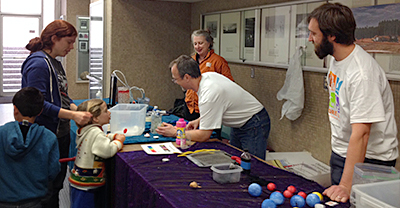
Susan Hovorka (Left) and Jacob Anderson (Right) make invisible CO2 real for a young visitor.
March 7, 2015: Explore UT: The Biggest Open House in Texas. GCCC staff participated in the annual expo, which spans the entire Forty Acres, hosting 500 busloads of students who arrive for a day full of fun and learning. GCCC activities developed by Susan Hovorka included "Find Gold" and "What to Do About CO2."
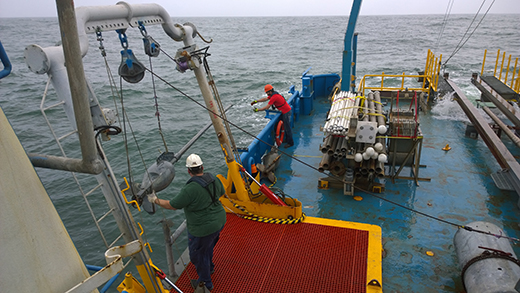
The torpedo-shaped instrument on the left side of the vessel is the lead head weight that pushes pipe into the sediment for coring.
February 21-22, 2015: Dr. Tip Meckel led a coring operation in the inner Texas shelf offshore Galveston Island. The study site was previously imaged in 2013 by Meckel and his collaborators using the UT Bureau of Economic Geology's high-resolution 3D seismic (Pcable). Seismic interpretations indicates that there is a deep-seated gas chimney at the site and identified a suite of shallow seismic anomalies at a depth 10 to 40 meters below the seafloor. These anomalies have been interpreted to be shallow free gas accumulations. The goal of this core sampling is to determine if the gas anomalies can be identified and resolved with the fine spatial detail imaged in the seismic data. The dataset provides important information for monitoring strategies for the future potential for offshore storage of CO2 in the stratigraphy beneath the offshore State Waters.
February 18, 2015: iPGST (informal Petrology, Geochemistry, Structure & Tectonics) Brownbag Lunch Seminar. Johnathon Osmond presented a talk, "Investigating possible mechanisms of containment failure within lower Miocene to Recent stratigraphy using 3-D seismic data in the San Luis Pass area, Texas Gulf Coast" The University of Texas at Austin, Austin, TX
February 9-11, 2015: The 5th Korea International CCS Conference. Toti Larson attended the conference on Jeju Island, South Korea and presented a talk, "Using coupled models and experiments to understand complex geochemistry of CO2 storage and transport of fugitive gases and fluids." He engaged in fruitful discussions with KCRC Director Dr. Sang-do Park and assistant Dr. Hwansoo Chong who are involved in the planning of onshore pilot CCS projects and commercial-scale offshore projects for the Korea CCS 2020 project. With assistance of GCCC Sponsor KCRC and Dr. Hunsoo Choi, Director of Geochemical Monitoring at KIGAM, which is a research group developing technologies for capture, transport and storage of CO2, Dr. Larson was also invited to speak about his work related to gas transport in the subsurface at the KIGAM research center in Daejeon City, South Korea.
Toti Larson speaks at the 5th International CCS Conference, and enjoys traditional Korean BBQ with KIGAM scientists: Kwon Gyu Park, Jeong Chan Kim, Young Jae Shinn, Hunsoo Choi, and Gutak Chae (Kue-Young Kim photo credit).
February 3, 2015: The Huffington Post published a piece by science writer Juli Berwald, who covers GCCC activities. The article is based on an archived GCCC blog by Tip Meckel, about the possibility of mitigating Keystone-XL pipeline emissions using CCS on the Gulf Coast.
February 2, 2015: Asia-Pacific Economic Cooperation (APEC) Workshop for CCS Capacity for Mexico and China. Vanessa Nunez was invited to speak. Kemper, MS.
January 26-30, 2015: International Organization for Standardization (ISO). Susan Hovorka participated in a meeting, which seeks to bring together experts from around the world to develop international standards for standardization of CCS. Birmingham AL.
January 26, 2015: Tip Meckel is the lead author with Steve Bryant and Ravi Ganesh on a new paper in the International Journal of Greenhouse Gas Control, "Characterization and prediction of CO2 saturation resulting from modeling buoyant fluid migration in 2D heterogeneous geologic fabrics" (link). The paper quantifies saturations for a broad range of clastic facies and depositional architectures, presents a two-dimensional invasion percolation saturation predictor model, validates IP predictor model with natural geologic specimens and field example, and provides implications of saturation variability for capacity estimation and seismic imaging.
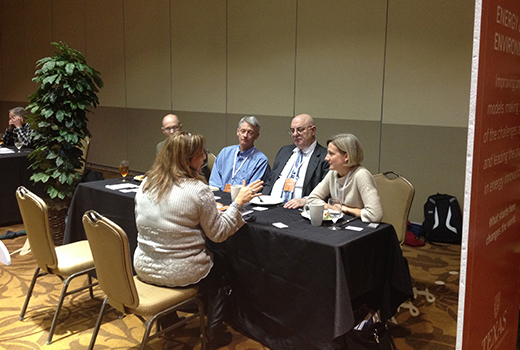
From left to right, Charles Werth, GCCC's JP Nicot, David Eaton, and Sheila Olmstead speak to an Austin-based reporter.
January 22, 2015: Legislative Media Open House for Texas Journalists. Katherine Romanak and JP Nicot participated in an open house organized by The University of Texas at Austin aimed at providing the media with expert technical information on legislation that may be proposed in the upcoming session. Austin TX.
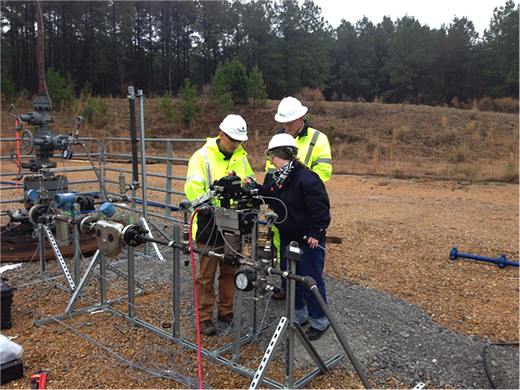
From left to right, Jiemin Lu, Paul Cook (LBL), and Kate Hart (EchoGen) test the controlled release system. Photo courtesy Dr. Barry Freifeld.
January 18-31, 2015: Alex Sun and Jiemin Lu led an experiment to demonstrate the efficacy of a harmonic pulse testing (HPT) technique for monitoring potential leakage from geologic carbon sequestration formations. HPT is a pressure-based, active monitoring technique for detecting the presence of leaks by modulating the injection pattern and monitoring observation well pressure responses. Because an actual example of well failure did not exist, the field project created a controlled release in order to simulate this negative event. The study site included a CO2 injector and two observation wells located approximately 300 ft and 400 ft away. During the experiments, the observation wells were instrumented with high-resolution pressure gauges. Controlled CO2 venting was engineered from one of the observation wells to simulate the worst-case leakage from the reservoir. Square pulses of different period lengths were imposed at the injector by maneuvering the wellhead choking valve. Preliminary analyses of pressure data show promising results. The field experiment was funded by DOE and NETL and coordinated with SECARB. It was conducted in collaboration with a team from the Lawrence Berkeley National Lab funded under a different project.
January 6, 2015: Along with David Bomse of Mesa Photonics, LLC, Katherine Romanak and Changbing Yang have won an SBIR/STTR FY 2015 Phase I grant for approximately $225,000 for their proposal "Real-time, in situ, process-based soil gas analyzer." This technology was born out of CCS monitoring research but is being supported for its overarching scientitifc value for understanding complex terrestrial systems.
The proposed project builds on two recent innovations. First, Romanak and her colleagues demonstrated that concentration measurements of four simple gases – oxygen, carbon dioxide, methane, and nitrogen – are sufficient to characterize and potentially quantify important activity in unsaturated sediments and soils including barometric pumping, aerobic and anaerobic biologic activity (respiration, denitrification and methane oxidation), and CO2 and carbonate dissolution. This approach has been demonstrated successfully at playa lakes where there is systematic spatial variability in CO2 formation and consumption, and at several engineered sites where exogenous gases were added to test the robustness of the process-based method. Second, Mesa Photonics demonstrated an all-optical technique for real-time measurements of the four key gases. Although inexpensive commercial sensors are available for CO2, CH4, and O2, measurements of N2 concentrations require expensive, cumbersome equipment that, in some cases, is incompatible with oxygen.
This project will lead to commercialization of fully-automated and self-contained soil gas analyzers. Each device will be about the size of a one-gallon container and could be powered by a small solar panel with battery backup.



